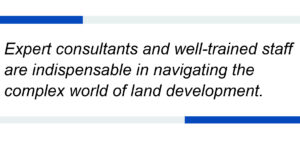 Subdivision grading and inspection are crucial elements in residential development, ensuring proper drainage and adherence to approved plans. Communities strategically coordinate the installation of new utilities and roadways to create additional residential lots within their boundaries, a process that directly drives economic growth and fosters community development.
Subdivision grading and inspection are crucial elements in residential development, ensuring proper drainage and adherence to approved plans. Communities strategically coordinate the installation of new utilities and roadways to create additional residential lots within their boundaries, a process that directly drives economic growth and fosters community development.
A specialized contractor typically manages the initial development by installing both surface and subsurface infrastructure, carefully grading the subdivision in strict accordance with approved engineering plans. Once the development meets all municipal standards and requirements, the municipality accepts ownership of the subdivision. At this point, individual lots become available for sale to prospective buyers.
The next phase marks a critical transition in the development process. Here, individual lot builders collaborate closely with property owners to create customized plans for each parcel. This tailored approach aims to meet specific needs and preferences while adhering to the subdivision’s original design standards. However, this stage often presents significant challenges for municipalities. They must balance individual property owners’ desires with the need to maintain the subdivision’s overall integrity and compliance with established regulations. Common issues include ensuring consistency with approved grading plans, managing drainage across multiple lots, maintaining infrastructure compatibility, and addressing potential conflicts between neighboring properties. Effective oversight and clear communication become crucial as municipalities navigate these complexities, striving to uphold community standards while accommodating individual homeowner visions.
Inspection Processes for Compliance
A robust review process is crucial to ensure final lot grades match approved plans. This process helps verify that each individual lot’s grade conforms to its respective approved drawing. This comprehensive approach involves strategically scheduling inspections after critical milestones in the construction process. A key component of this process is the meticulous verification of compliance with local regulations, standards, and the approved plans. This is typically achieved by using detailed checklists that cover essential aspects like slopes, drainage systems, and elevations.
The process typically begins when a new building permit is pulled for a vacant lot. The property owner or builder prepares and submits a detailed grading plan to the municipality for comprehensive review, outlining how the lot will be constructed.
The municipality carefully reviews and either approves or rejects the submitted lot grading plan by verifying it against the approved subdivision plan — a critical step often overlooked during inspections. Throughout the development process, revisions are common, and municipalities can easily lose track of the “final” version unless meticulous file management and revision tracking are implemented.
Once construction begins, builders use these approved lot grading plans as their primary guide for site development. After completing their site work, builders notify the municipality to schedule and conduct official lot grading inspections. To enhance efficiency and accuracy, many consultants, developers, and municipal inspectors are now adopting real-time validation tools. These advanced technologies significantly streamline the reporting process and enable more effective compliance monitoring, allowing for rapid identification and resolution of any discrepancies between actual site conditions and the originally approved plans.
By implementing such a thorough and technologically supported inspection process, the ability to maintain high standards of quality and compliance throughout the overall subdivision grading process is more achievable.
Challenges in Subdivision Grading
Subdivision grading projects face several critical challenges that can significantly impact their overall success.
- Finished floor structure elevations often vary, creating complex terrain with inconsistent slopes that can affect drainage and accessibility. While subdivisions frequently include sidewalks or walking trails as amenities, these pathways are rarely graded or constructed to meet acceptable pedestrian compliance or required grade standards. Failure to meet ADA compliance standards not only creates legal risks, but also fundamentally limits accessibility for residents with mobility challenges. Technical hurdles like drainage issues compound these problems, potentially leading to water accumulation near structures or inadequate water conveyance that can further compromise pathway usability and safety.
- Regulatory complexities further complicate the process, as developers must navigate a maze of local zoning ordinances, environmental regulations, and planning rules, all of which can vary significantly by region.
- Logistical constraints significantly impact subdivision grading. When upstream lots are developed before downstream ones, the proper grading of the subdivision can be compromised. These are often attributed to deviations in elevations, slopes, and grades from the approved plans.
- Budget limitations can restrict the scope of grading limits, while time constraints may pressure teams to expedite processes, thereby sacrificing quality.
Techniques & Tools for Final Grade Checks
Utilizing advanced software like AutoCAD Civil 3D, Survey 123, and ArcGIS allows for real-time, accurate data collection that ensures precise grading is performed on each respective lot. These tools ensure that the lot terrain grading conforms to approved plans for items such as drainage lines and building pads.
Conclusion
Expert consultants such as raSmith and well-trained staff are indispensable in navigating the complex world of land development. Their comprehensive expertise spans critical areas such as regulatory compliance, environmental assessment, infrastructure planning, and community engagement. These professionals bring specialized knowledge and strategic insights that help developers tackle intricate challenges throughout the project lifecycle.
By leveraging their technical acumen, project management prowess, and conflict resolution skills, these experts ensure a smooth progression from conception to completion. Their advocacy efforts and deep understanding of local regulations streamline processes, potentially saving developers significant time and resources. As the property development industry evolves, the value of experienced professionals becomes increasingly apparent.
These skilled individuals adapt to changing regulations, implement sustainable practices, and foster positive community relations. Their ability to navigate complex challenges makes them crucial partners in creating successful, compliant, and environmentally responsible subdivisions. Ultimately, by enlisting their services, projects significantly enhance their chances of achieving successful outcomes, resulting in vibrant, enduring communities that stand the test of time.
